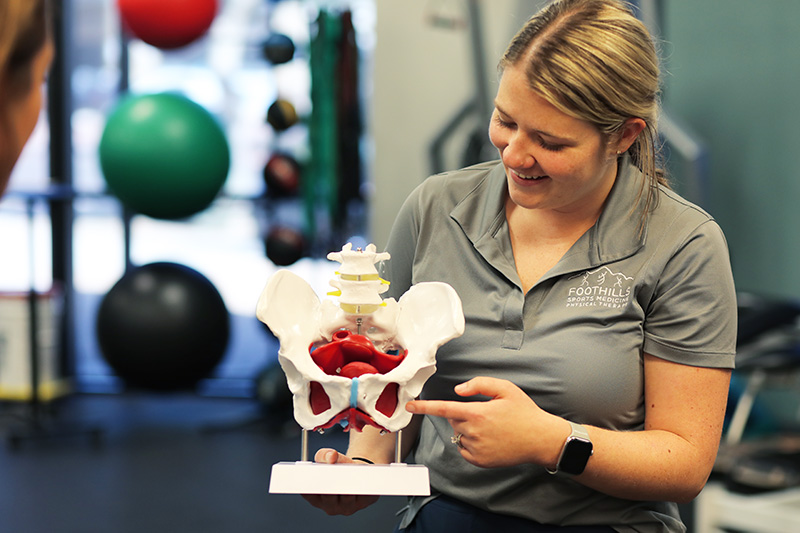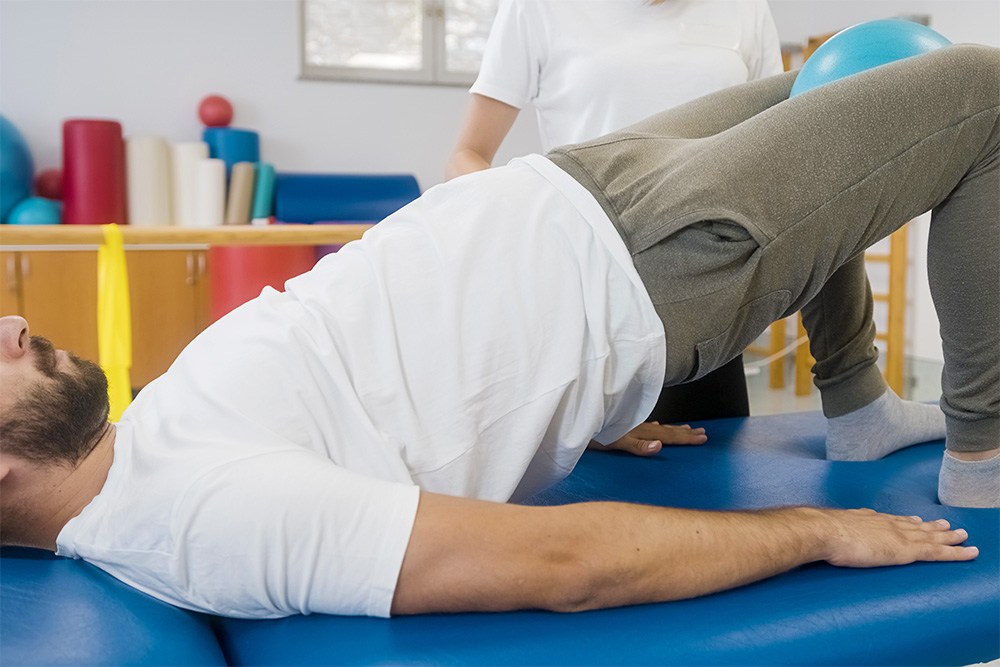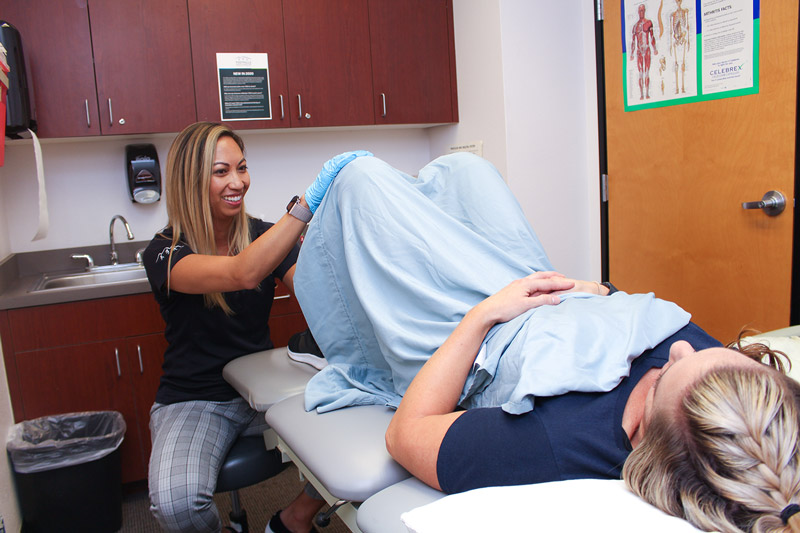by Kandice Rogers, PTA, BFR, MFD.
Kegel exercises are popularly known to strengthen pelvic floor muscles. They were developed in the 1950s as a means of helping patients deal with urinary incontinence (UI); however, several other advantages have been discovered over the years.
These pelvic floor exercises have become well known in recent years as the public has become aware of how important pelvic floor muscles are. Your pelvic muscles are vital for proper sexual function, avoiding incontinence, and more. In addition, the pelvic floor muscles serve as a hammock to support your pelvic organs, including the bladder, bowels, and reproductive organs. Kegel exercises help alleviate pain during sex, prevent fecal and urine leakage, treat pelvic pain and prevent more severe health problems.
Although Kegels are most known to benefit women, men can also see improved health from performing these exercises routinely. Read on to learn the proper techniques and the benefits of doing Kegels for both sexes.

Benefits of Kegels
When properly functioning, our pelvic floor muscles rarely cross our minds. However, as we age, they may begin to weaken. As a result, pelvic organ prolapse (POP) concerns many older adults. Pelvic organ prolapse, in essence, is caused by the pelvic floor’s weakening, resulting in the rectum and bladder dropping below their usual place in the body. This can result in incontinence, difficulty in elimination, and more.
Kegel and pelvic floor exercises are a fantastic way to prevent POP. They also sure up the organs in the lower abdomen providing additional support to our core muscles and a strong foundation supporting our organs. As with all of our muscles, strong pelvic floor muscles offer various benefits.
Kegel Exercising Precautions
When performing Kegels, it is essential not to hold your breath and ensure you’re not performing a Valsalva maneuver. A Valsalva maneuver is performed during a bowel movement or when someone stops the kegel exercise mid-stream. Coordinated breathing during pelvic floor exercises promotes pelvic floor strength, endurance, and coordination. The pelvic floor muscles should contract appropriately during everyday activities and actions and involve breathing simultaneously.
Women
POP in women can even cause these organs to exit or enter the vagina, leading the vaginal tissues to begin protruding from the body, even after a hysterectomy. The following is a list of factors that increase your risk of POP:
- Vaginal birth
- Pregnancy
- Genetics
- Surgery in the pelvic area (hysterectomy or C-section)
- Frequent sneezing, coughing or laughing
- Genetics
Exercising the muscles in your pelvic floor with Kegel exercises and pelvic floor therapy aids in supporting the intestines, bladder, rectum, and uterus. It also helps manage and prevent urinary incontinence, reduce pelvic pain, intensify sexual climax, and improve sexual satisfaction.
Men
Notably, Kegels are not only valuable for women. Maintaining strong muscles on the pelvic floor offers benefits for men, as well. By doing pelvic floor exercises, men enhance their sexual function. These exercises also aid in supporting their bowels and bladder and can help treat prostatitis and benign prostatic hyperplasia (BPH) related to prostate discomfort and inflammation. If you leak after urinating or struggle with bowel or bladder incontinence, Kegels can be helpful.

How to do Kegels for Women
It is important to learn how to do Kegels properly. These exercises are particularly essential during pregnancy and after childbirth. Before beginning any of these exercises, it is necessary to locate the Kegels. Your physical therapist or doctor can offer in-depth information. However, finding the Kegels is generally possible through:
- Noticing the muscles that help control urine flow. Those are the muscles you should strengthen
- Insert a finger into the vagina and tighten the muscles around it. The muscles that pull are the pelvic floor muscles
- When using a vaginal weight, the pelvic floor muscles help keep the weight inside the vagina.
Below is a step-by-step guide on how to do Kegels for women:
- Loosen your chest, abdomen, thighs, and buttocks.
- While contracting the muscles in your pelvic floor as if preventing urination, hold the contraction for 5 to 10 seconds.
- Release the muscles for the next 5-10 seconds.
- Rest for another 5 to 10 seconds.
- Repeat three sets of this ten times each day.
The objective is to maintain the contraction for at least 10 seconds every time as it allows the muscles to become stronger over time. During the contraction, watch for an upward motion and vaginal, bladder, or anus stiffness. This confirms that you are doing the correct procedure.
You can also utilize biofeedback to evaluate your form. For example, a medical practitioner will use a device to track the workouts’ time, the pelvic floor’s firmness, and muscular contraction.

How to Do Kegels for Men
In men, identifying the muscles in your pelvic floor is a bit different. They can be located by:
- Determining which muscles contract by restricting your urine flow.
- Lying on your back, relax the stomach, abdomen, and buttocks. Then tighten the muscles around the anus.
- Standing, relax the abdomen, buttocks, and stomach. Contract the lower abdomen (the reproductive organs should draw closer to the body).
For further proper guidance on locating the pelvic muscles, it is advisable to visit your physical therapist or physician. Your doctor may use biofeedback to determine your current pelvic floor strength and whether you are correctly engaging your pelvic floor when attempting Kegel exercises. From the measurements, the doctor can guide you on how to do these exercises in men more effectively.
Muscles for men’s pelvic floor often weaken due to age or prostate surgery. Follow the steps below for the proper way to do pelvic floor exercises in men:
- As you breathe normally, loosen the muscles in your midsection, buttocks, and thighs
- Find the muscles of the pelvic floor
- As if trying to stop peeing, tighten them
- Hold for three seconds, and then let go for three seconds
- Do three sets of this ten times each day

When Should You Seek Pelvic Floor Therapy from your Physical Therapist?
If the Kegels are working, you will notice the exercises become easier, the need to urinate will become less frequent and less urgent, and incontinence will be reduced or eliminated. The benefits might not be evident immediately. However, over several weeks, you should begin to see improvements.
If, after several weeks, you are still experiencing symptoms such as leaking urine and frequent urination, it may be that your situation requires assistance from a pelvic floor therapist. However, if the steps you are taking to strengthen your pelvic floor are ineffective, it is vital to see your physical therapist immediately.
A professional physical therapist will evaluate your condition and determine your most effective therapy methods. With the guidance of a physical therapist and a doctor, you can find relief from the effects of weak pelvic floor muscles. Only under the supervision of a medical professional can you guarantee that you are doing Kegel pelvic floor exercises correctly.
Consult a Pelvic Floor Physical Therapist at Foothills
Kegel exercises for men and women can have benefits beyond those listed here. However, it is important to consult a physical therapist to gain the most significant advantage from your efforts. If your doctor suggests pelvic floor exercises or therapy, it is advisable to begin immediately to prevent further risk of damage or prolapse.
At Foothills Physical Therapy, our physical therapists are skilled at providing pelvic floor therapy and any information you might need about Kegels. Schedule a physical therapy appointment immediately if you have questions regarding Kegel exercises or pelvic floor therapy.




